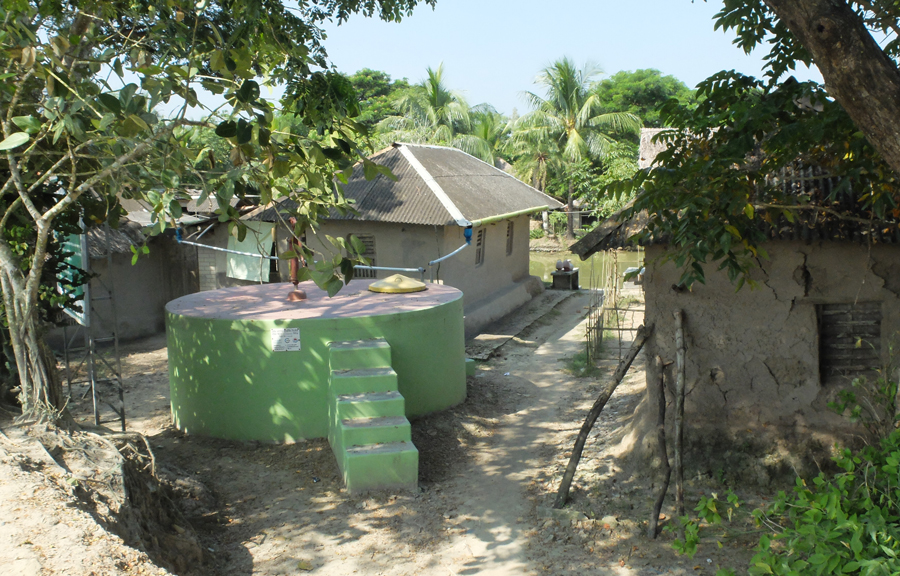Drought like situation has been one of the biggest enemies of farmers in Bangladesh. The country has a record of drought spells. In 1999, Bangladesh suffered the longest drought in 50 years, with more than four months without rain; and in 2010, the country recorded its lowest rainfall since 1995. In the recent past, droughts were more frequent in Bangladesh than in the past because of climate change (NDMC, 2006) and it appears in every five years.
Each year about 0.45 Mha of land is affected by very severe drought during rabi season whereas 0.40 and 0.34 Mha are affected during pre-kharif and kharif seasons, respectively (Yu et al, 2010). High Barind Tract is among the severely drought affected area since time immemorial.
Drought caused by inadequate rainfall is the most important climatic anomaly which has impacted agricultural production in HBT. Occurrence of droughts is an annual event like floods. Drought is most widespread and damaging of all environmental stresses, affecting rainfed rice in the HBT.
Drought prevails during pre-kharif, late-kharif, and rabi season. Because of an increase in area under irrigation and introduction of new crop varieties, the impact of drought has reduced to some extent. However, droughts will be more frequent and more intense in Bangladesh due to climate change that will also aggravate the scarcity of water.
High Barind Tract is flood free zone. Low rainfall and unpredictable climatic condition make agriculture difficult here. The Barind Multipurpose Development Authority (BMDA) has long been trying to increase irrigation coverage through installation of deep tube-wells.
However, installation of numerous deep tube-wells could not ensure production of crops as farmers are not able to pay for irrigation as well as certain difficulties, specific to HBT including depletion of groundwater, and those are of concern for sustainability of crop production. Considering the constraints of HBT, rainwater harvesting for crop production in the HBT could be a sustainable solution. It is expected that use of rainwater will save farmers’ money as well as increase production.
Rainwater harvesting (RWH) is a method of inducing, collecting, storing, and conserving local surface runoff for agricultural production. Farmers in water scarce areas like HBT face difficulties in agricultural production due to unavailability of water at right time and in right amount.
Rainwater harvesting can be effectively used by farmers to overcome the hardships of nature. Use of rainwater harvesting for agriculture is common as a result of the irregular nature of rains in many countries and is widely practiced in areas where there is irregularity in seasonal rains. Rainwater harvesting technology helps to store water in rainy seasons, for usage, during the drought period.
Amount of rainfall in HBT is less, around 1200-1400mm per year, which is the lowest among all areas of Bangladesh. This area is characterised by delayed arrival of seasonal rain (mid-May) and early withdrawal (mid-October).
Main rainy seasons cover only four months (June to September). However, in most cases less rainfall is observed in most of the years which is insufficient than required. Due to elevation and distance from rivers, main source of groundwater recharge in HBT area is rainfall.
Nature of soil surface restricts percolation of surface water into the ground and increases surface runoff; as a result groundwater recharge is less in HBT. Due to continuous withdrawal of water for irrigation, groundwater level is continuously falling by years. Scientists therefore recommended less use of groundwater for irrigation in this area to maintain the groundwater table within suction limit. Therefore, the only alternative is rainwater.
The Bangladesh Agricultural Research Institute (BARI) has recommended rainwater harvesting back in 1993 for High Barind Tract (HBT). On-farm research division of BARI published “Harvesting rain water for crop production in dissected Barind tract” with research results and recommendations of specific technologies. The research suggested excavation of mini pond for irrigation to increase farm income. According to the research, mini pond can increase profit up to 23% from the same piece of land. Only a small portion of land (2.5%) is sufficient for storing rainwater to provide irrigation if crops are selected carefully, according to the BARI study. To avoid land degradation caused by improper cultivation in terrace land and higher rate of groundwater depletion in HBT, proper initiatives should be undertaken. Coordinated efforts should be taken. Recently, Bangladesh government has also reached a position to avoid groundwater for irrigation in the HBT. Government has imposed a ban on installation of new DTW in HBT. Motivational package is being offered by the government to avoid cultivation of irrigation intensive boro rice in the area. According to its mandate, the BMDA have to take the lead and coordinate all activities in the Barind area. BMDA’s mission, vision, and objectives are very clear in this regard. The major development priority of BMDA, particularly concerning the development of agriculture, include augmentation of surface water resources and its use, installation of deep tube-wells to facilitate irrigation using groundwater, re-excavation of ponds/khal for pisciculture development and irrigation, afforestation to achieve environmental and ecological balance, etc. It should be noted that the number one objective of BMDA is to increase irrigation facilities through use of surface water. The organisation is working in this regard. BMDA re-excavated 42 khals during 2015-2016 financial year. The first Barind Agro-eco Innovation Research Platform Conference held on January 29, 2017 organised by BMDA suggested low cost preservation technologies of rainwater harvesting. Scientists in the conference have cautioned regarding the danger of ground water depletion and recommended policy planning needs for small holder irrigation water use. It is therefore expected that the BMDA will take the lead to increase surface water use through promotion of rainwater harvesting technologies. National Agricultural Research System (NARS) organisations shall continue research to find out new technologies to ensure water efficiency and will continue sharing knowledge with BMDA. The initiative of Agro-eco Innovation Research Platform by BMDA can be used for knowledge sharing and technology transfer for sustainable development in the HBT.



